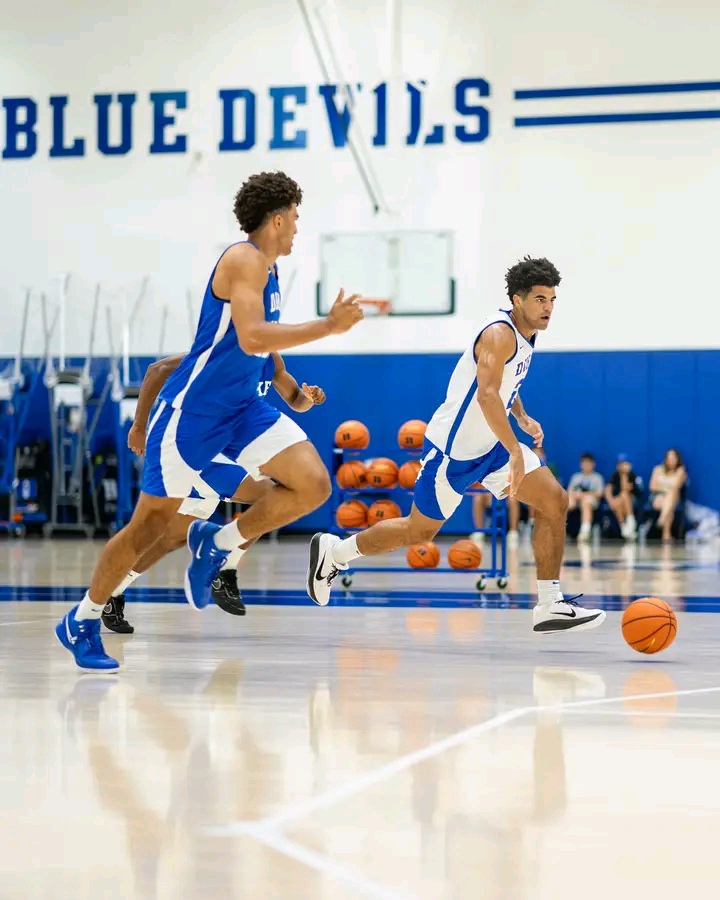Duke’s summer practices are always intense—but this year, they’ve taken on a new edge. The buzz? It’s not just about the stars. It’s about the depth.
Coaches, insiders, even teammates are starting to admit the unthinkable: the second unit might be more dangerous than the starters.
And if that’s true, Duke could be walking into the season with one of the most complete rosters in college basketball.
The Starters Are Solid—But the Bench is Surging
You expect names like Caleb Foster, Isaiah Evans, and Maliq Brown to carry the early headlines. Foster has been commanding Duke’s offense with more control and maturity. Evans, entering his sophomore season, looks physically stronger and mentally sharper. And Brown, the transfer-turned-leader, has added stability in the frontcourt with his voice and physicality.
Patrick Ngongba II, now in his second year, has made noticeable strides in conditioning and footwork. He’s not just a defensive anchor—he’s starting to demand touches inside, adding a layer to Duke’s post play that was missing last year.
But it’s when the second group checks in that things get interesting.
Dame Sarr and the Freshmen Make Their Case
Dame Sarr is drawing attention fast. The freshman Italian wing is long, fluid, and fearless. During scrimmages, he’s matched up with veterans and hasn’t blinked. His footwork is clean, his shot smooth, and his motor non-stop. Coaches are already asking: is this guy too talented to bring off the bench?
Cameron Boozer brings power, patience, and polish. The game just seems to slow down when he’s on the floor. Whether he’s hitting short jumpers, drawing doubles in the paint, or dishing from the high post, Boozer is proving his game translates right away.
And don’t forget his twin—Cayden Boozer. As a floor general, he’s calm and calculating. He’s running the second unit like a seasoned vet, keeping things tight while letting scorers cook. His control in pick-and-rolls and defensive communication have turned heads early.
Nikolas Khamenia is a glue guy with an international feel. He’s not dominating drills, but he’s everywhere—diving for loose balls, switching onto guards, knocking down spot-up threes. He plays like someone who belongs.
Sebastian Wilkins, the reclassified forward, might be raw, but his athleticism is hard to ignore. He’s had moments in transition where he simply outruns and outjumps everyone. He’s a developmental piece, yes—but he’s already making noise.
Returners Providing Backbone
Among returners outside the spotlight, Darren Harris has become one of Duke’s most consistent shooters in practice. His role may be shifting, but his stroke is still pure—and in five-on-five drills, he’s showing he can hold his own defensively.
Cameron Sheffield, a hybrid wing, has quietly been one of the most versatile players on the roster. He can defend multiple positions, rebound, and make simple plays. Coaches love his experience and willingness to play any role asked of him.
And then there’s Spencer Hubbard, the 5-8 walk-on guard who continues to push teammates in drills, challenge them in conditioning, and bring the kind of competitive edge that programs quietly thrive on. Every practice needs a guy like Hubbard—and this year, his voice has gotten louder.
Competition Is Changing Everything
What’s happening in Durham is simple: the bench isn’t waiting. They’re forcing the issue. Some days, they outplay the starters. Some days, they run them off the floor in scrimmages. And with this much talent, Jon Scheyer may not have a traditional starting five—he may have a starting ten.
This isn’t about demotions or surprises—it’s about optionality. Duke’s second unit might just be the biggest advantage they have come conference play.
And if they keep practicing like this?
Opponents won’t get a break—not when the subs check in.

